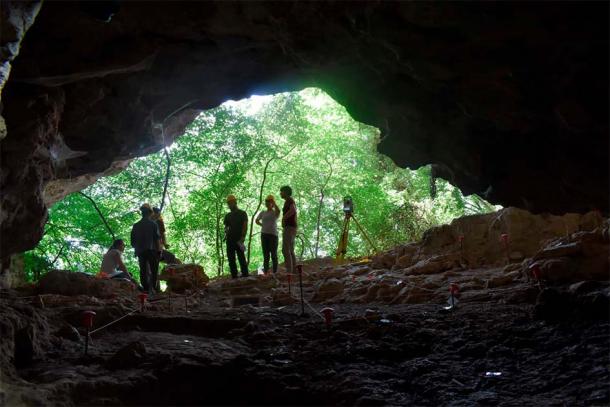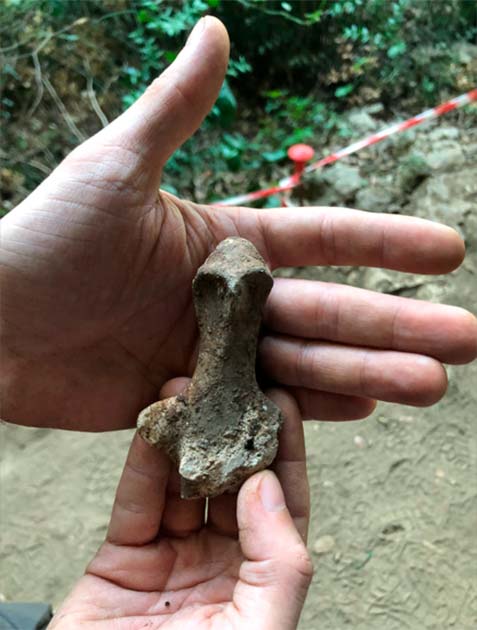ROME – Sapienza University in Rome has announced in a statement the discovery of a puzzling 7,000-year-old figurine. The “very rare find” is reminiscent of a female doll, and it has sent shockwaves through the archeological community.
The clay statuette was found in the Battifratta Cave located in an area that is “almost absent” of artifacts in the Rieti province northeast of Rome tucked in the central Apennine Mountain range that runs the spine of Italy. The enigmatic artifact has been described as holding the potential to redefine our understanding of early human societies in the region.
The Battifratta Cave itself is an extraordinary natural creation. It is nestled deep within the rugged landscape of the Apennines. The cave sits along a tributary of the Farfa river and the cave itself is the source of an ancient spring.
Excavations at the site began in 2019, led by Dr. Elena Rossi, a renowned archaeologist specializing in prehistoric cultures. The excavation has been carried out by La Sapienza since 2021 through its Sapienza Grand Excavations Fund and under an agreement with the Ministry of Culture and the archeological Superintendency of Metropolitan Rome and the Province of Rieti.
The discovery of the Battifratta Cave Figurine, as it is now known, is simply “unique” having no comparable object from the area. It has sent ripples through the archaeological community, potentially shedding new light on the rich cultural heritage of an ancient civilization and re-writing what is known about the ancient inhabitants of the region.

Entrance to the Battifratta Cave, Sabina, Italy. ( via Sapienza University of Rome )
The figurine depicts a humanoid figure, believed to be female due to its characteristic shape and facial features. The figurine is adorned with an intricately carved headdress, possibly symbolizing her elevated status or religious significance. The figurine’s arms are outstretched as if embracing the world around her, while her body is adorned with symbols and patterns, the meanings of which are yet to be deciphered. The intricate nature of the carving suggests a high level of skill and suggests that it held great importance to the culture that created it. The features of the object are still only suggested; more work will need to be done.
The artifact is believed to be at least 5,000 years old and likely over 7,000 years old. A period when the earliest farming communities were established on the Italian Peninsula.
It measures only 2.75 inches (7 centimeters) in height. It is crafted from soapstone and showcases a remarkable level of craftsmanship and attention to detail.
The figurine is an exquisite representation of artistic expression, but the location and design may also hold some tantalizing clues about the rituals, beliefs, and social structures of a long-lost civilization.
As might be expected, the Battifratta Cave Figurine is now the subject of vigorous multidisciplinary study, coordinated by the Department of Ancient Sciences of Sapienza. Researchers hope to better understand its stylistic aspects as well as determine the technology that made its creation possible.
One of the most intriguing aspects of the Battifratta Cave Figurine is its context within the cave itself. The figurine was discovered in a chamber within the cave that seemed to have been deliberately sealed off from the rest of the cave system. This suggests that the chamber may have held a special significance, potentially serving as a sacred space or a repository for important artifacts. The spring was used for more than water. It was also likely used for “burial and ritual purposes.”

7,000-year-old Battifratta Cave Figurine. ( via Sapienza University of Rome )
The cave may still have more secrets. The figurine’s placement within this context raises questions about its role within the ancient culture, possibly as a representation of a deity or a talisman used in religious or spiritual practices. But more research must be conducted to make better determinations regarding why the object was in that location.
“The presence of lithic-industrial ceramics, faunal and botanical finds on several stratified levels,” explains Cecilia Conati of Sapienza University “reveals the use of the spring and the cave not only for the supply of water but also for sepulchral and ritual purposes, such as testify the human skeletal remains found and the clay figurine.” But whether the object has funerary or fertility meanings remains unclear.
To further unravel the mystery surrounding the Battifratta Cave Figurine, researchers have turned to a variety of scientific techniques. Radiocarbon dating places the figurine’s creation around 3000 BCE, making it one of the oldest known examples of representational art in the region. Chemical analysis of the soapstone has revealed traces of red ochre, a pigment commonly associated with rituals and ceremonies. This finding provides valuable insights into the pigmentation techniques employed by the ancient artisans and hints at the cultural significance of color within their society.
Moreover, comparisons with other contemporary artifacts from neighboring regions have been made to identify possible cultural connections. Similar figurines have been found in nearby caves, suggesting the existence of a broader artistic and symbolic tradition that extended beyond the boundaries of a single community. This finding opens exciting possibilities for understanding the interconnectedness of ancient cultures during this period.
The discovery of the Battifratta Cave Figurine highlights the importance of ongoing archaeological research in uncovering the secrets of the past. As researchers continue to analyze and interpret the artifact, they hope to gain deeper insights into the spiritual beliefs, social structures, and artistic expressions of the ancient civilization that created it.
The figurine serves as a tangible link to a distant past, offering a glimpse into the lives and aspirations of people who once inhabited the region. It may also point to new areas for excavation and discovery.
Sapienza researchers explain that the Battifratta Cave Figurine represents a significant milestone in our understanding of ancient cultures. They noted that this beautifully crafted artifact, with its symbolic significance and mysterious origins, provides a rare opportunity to explore the complexities of the ancient people that created it.
A significant amount of that multidisciplinary research still has to be conducted to better understand what this object is and what it is for. As Sapienza asks in their statement, are we looking at a doll, a woman, or a god? It may end up being all three.
The Wild Hunt is not responsible for links to external content.
To join a conversation on this post:
Visit our The Wild Hunt subreddit! Point your favorite browser to https://www.reddit.com/r/The_Wild_Hunt_News/, then click “JOIN”. Make sure to click the bell, too, to be notified of new articles posted to our subreddit.